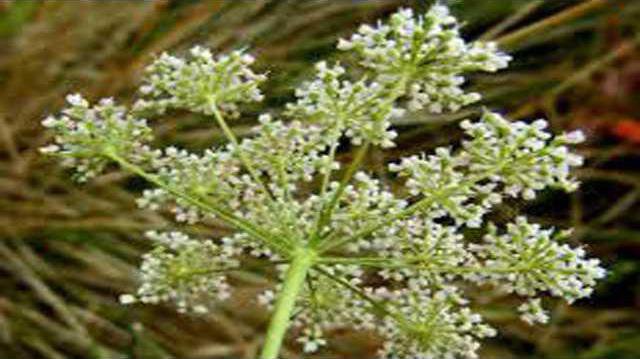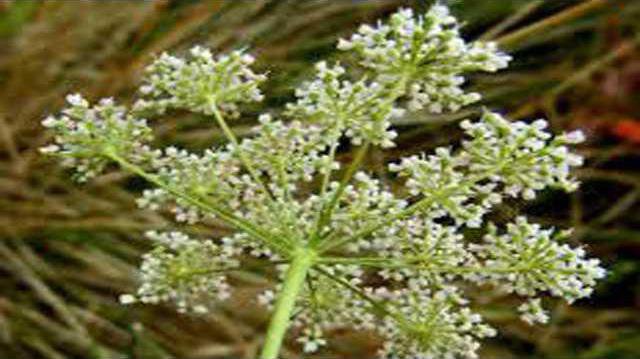CRAWFORD COUNTY - Burnet saxifrage, a plant native to the British Isles, appears to be making a concerted effort to take up residence in Crawford County. The plant is a highly aggressive invasive, and resembles another plant most are familiar with – the wild carrot or Queen Anne’s Lace. In Britain, the native species is a wetland plant, used for stream bank restoration.
Julie Borodin, who owns a 21-acres property on Turben Ridge Road, has worked for many years on a prairie restoration project on her land. She is very active on her property, and along Turben Ridge and Pine Knob Road, in identifying, mapping and eradicating the invasive species. Unfortunately, she has observed its spread into a very broad and diverse area of Utica Township as well.
On the UW-Green Bay website, ‘Hebarium: Cofrin Center for Biodiversity,’ www.uwgb.edu/biodiversity/herbarium, Pimpinella saxifraga is described as an herbaceous perennial, up to about 2-3 feet tall, with compound clusters of small white flowers, and leaflets arranged on either side of the stem, typically in pairs opposite each other. The website further explains that it is probably often overlooked, because of its superficial similarity to the very common and abundant wild carrot (Daucus carota).
The species is described on the Wisconsin DNR website as a plant which invades grasslands and woodlands. The plant prefers a dry, well-drained, chalk or limestone soil, but also grows well in rich soils and occasionally acidic sands.
The plants have very high seed production, and produce the seed continuously over a very long growing season. Plants have been observed in full flower even as late as early November.
The website further explains that the plant rapidly spreads by human activity and vehicles, especially along roadsides.
The plant is classified in Wisconsin as ‘restricted,’ which means it is an invasive species that is already established in the state, and causes or has the potential to cause significant environmental or economic harm, or harm to human health.
Eradication
Borodin is ringing the bell about this invasive species, which she says has the capability to suffocate other plants species, including native, other invasive, and even agricultural plant species.
“Burnet is highly aggressive and a prolific producer of seeds throughout the growing season,” Borodin explained. “It has the capacity to grow in every kind of environment, from dry, shallow soils over limestone, to deep, moist soils in woodlands and roadside ditches.”
The plant is spread through wind-blown seed, through animal and vehicle traffic through an established patch into adjacent areas, and especially through mowing and agricultural activities such as planting, harvesting and baling and moving of hay.
“I have been in discussion with the staff of the Kickapoo Valley Reserve near LaFarge, and they have observed the plant germinating in a Roundup ready soybean field, after harvest, in November.”
The upper part of the plant, according to Borodin, is composed of wispy leaves and clusters of flowers. She emphasizes that it is the lower leaves of the plant, which grow close to the ground, and the lateral and tap roots of the plant that are key to slowing and reversing the spread.
“The plant joins with other plants in its vicinity to form a dense carpet, which is how it is able to dominate an area and choke out other species.
Borodin describes her approach to eradicating the plant as a ‘take no prisoners approach.’ “Even one plant can result in the spread of the species because it is such a prolific producer of seeds,” Borodin emphasized.
Borodin explains that the kind of conservation activities such as pulling or mowing, used to eradicate other invasive species, are not effective with Burnet. She reports that the Minnesota DNR, which has struggled to control the plant in their state parks, reports that even use of common herbicides such as 2-4D are ineffective.
Angela Isackson, a staffer at Three Rivers State Park, in Minnesota, has been battling Burnet on the department’s properties. She has been one of Borodin’s resources in expanding her knowledge of the species and discussing best eradication practices.
"The acres of spread we have at Elm Creek Park Reserve are astonishing,” Isackson said. “Most of the old fields are completely covered in a dense carpet where Burnet is outcompeting Brome and Oxeye Daisy, which is not a good sign."
Isackson went on to explain, "We are highly concerned about this plant and fear it may be an issue for other landowners, who are not aware of the proper identification and what could be on the horizon for them as a takeover."
The quickest, easiest strategy to help control the spread of Burnet is to cut the flower clusters off the plant to prevent it from producing seeds. This can work best with small isolated patches.
Borodin has found careful use of extremely small amounts of the herbicide Escort XP plus MSO, a soybean oil based ‘adjuvant’ or amplifier, to be effective if just a few drops are applied to individual plants on the lower leaves. She emphasizes that this approach is also best used in isolated patches to prevent them from spreading.
Borodin has taken the lead in increasing awareness of this little-known invasive, working with local highway and road maintenance, and conservation groups.
Her efforts were successful in reaching Crawford County Conservationist David Troester and Crawford County Highway Commissioner Dennis Pelock.
“We identified a large patch of Burnet along the side of the road on County Highways C and J near Pine Knob, and we sprayed it with Escort XP,” explained Highway Commissioner Pelock. “We know that one of the key ways this plant is spread is through mowing, so I’ve directed my crew to leave those stretches alone for a while to give the herbicide time to soak in and really kill the roots.”
Pelock explained that his crews are aware of the problem along roads the county maintains, but they do not work on roads maintained by the townships where the plant has also been observed.
Borodin has also been in contact with the Utica Township road crew, who have been very receptive to her concerns. She emphasizes that what is needed is citizen vigilance and a volunteer effort to send crews out on the roadsides to spot treat the isolated patches to prevent its spread.
Project Stop Burnet
Borodin has worked tirelessly along her little stretch of road, and is happy to share her passion and lend assistance to others who are interested in joining her efforts. She calls her initiative ‘Project Stop Burnet.’
“This invasive must not be allowed to build in the environment. It is a threat to the floristic diversity and richness of the Driftless Area,” Borodin said. “Immediate funding is needed to address Burnet along rights-of-way and escaped Burnet spreading into private land. Burnet could easily dominate both upland settings and wet, mesic hollows and ravines. Riparian areas are also threatened, as this plant grows on river and stream banks and appears to tolerate periodic flooding. Its spread in one year is remarkable!”
Borodin can be reached at 608-256-3239, or by e-mail at jborodin@chorus.net. When she is at her land in Crawford County, her access to both phone and e-mail is extremely limited.
Borodin says she is looking for volunteers to join her in her efforts. She says if people contact her, she would be happy to talk with them or even come to their properties or locations, if close by, to help with identification and mapping. She is also willing to supply a small quantity of herbicide to help begin eradication efforts.




